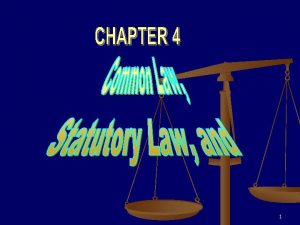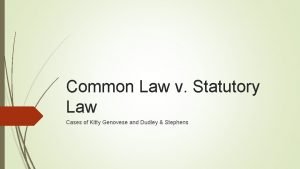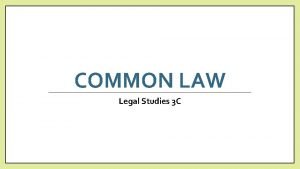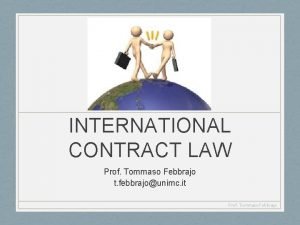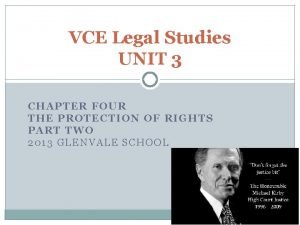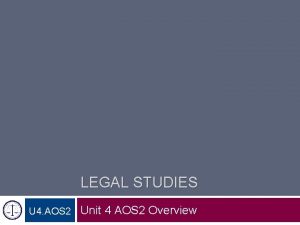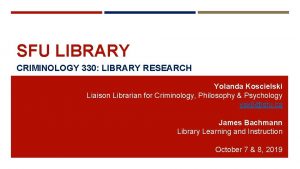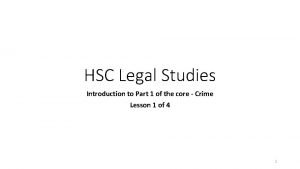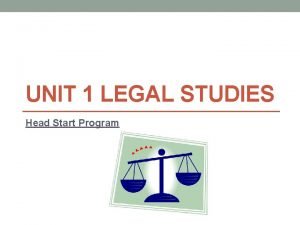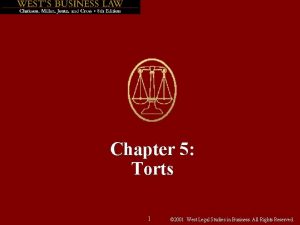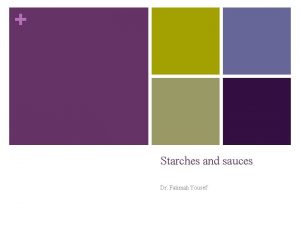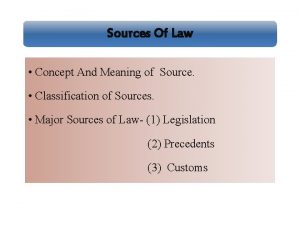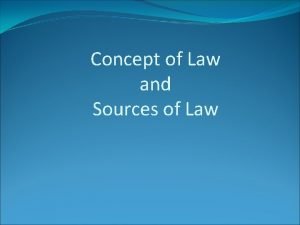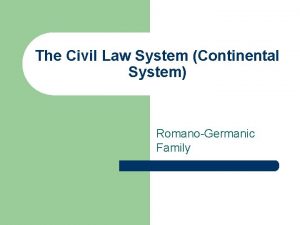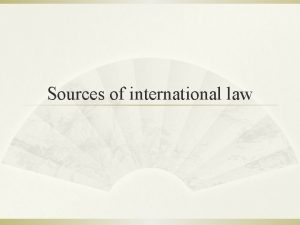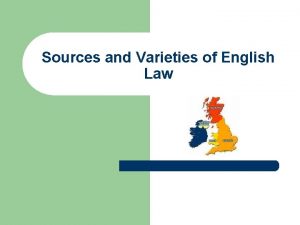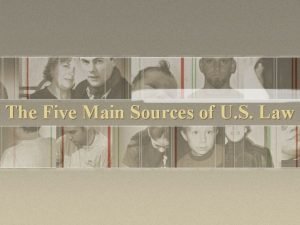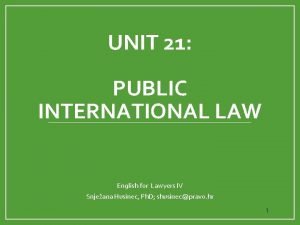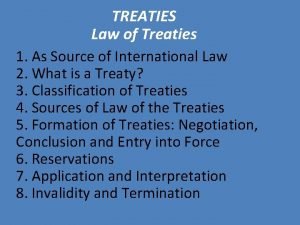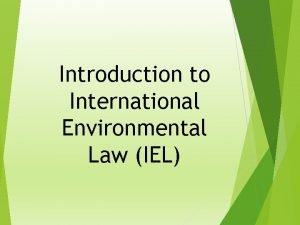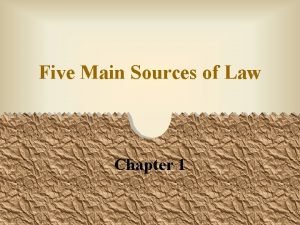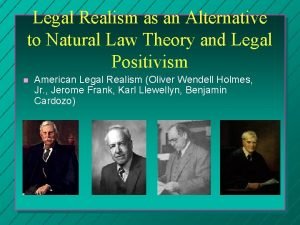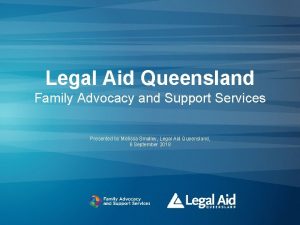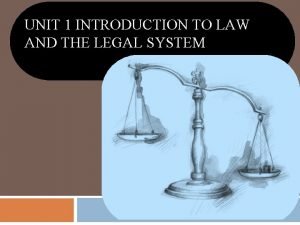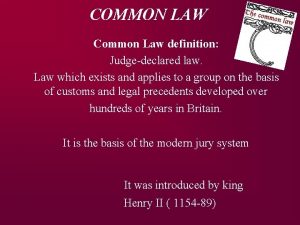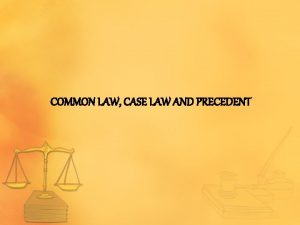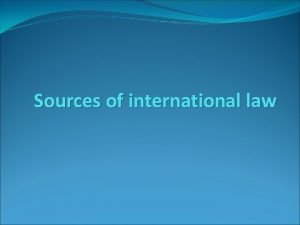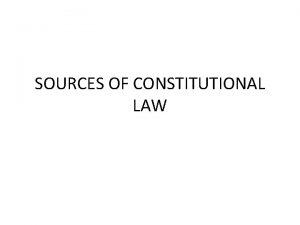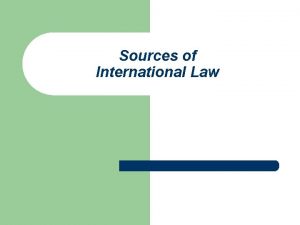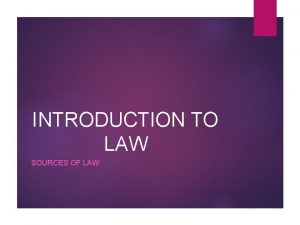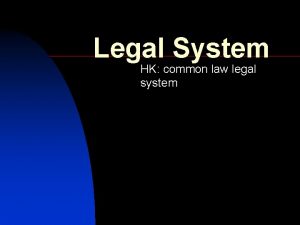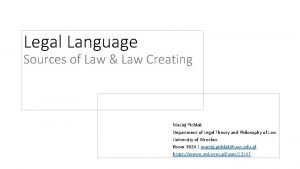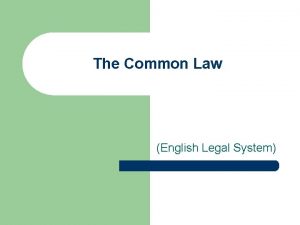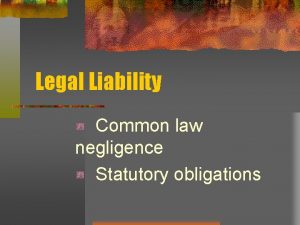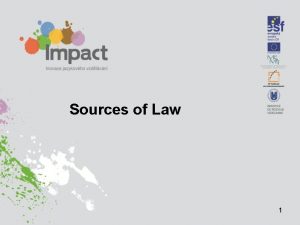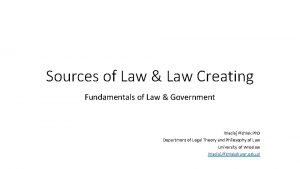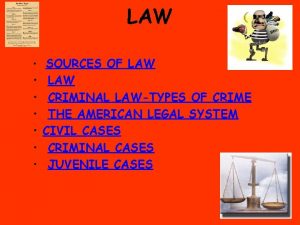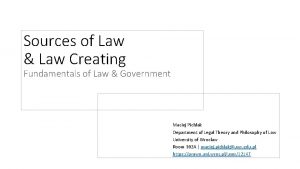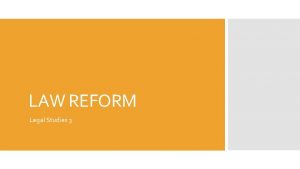COMMON LAW Legal Studies 3 C Sources of




































- Slides: 36

COMMON LAW Legal Studies 3 C

Sources of law in Australia Common law Parliament • Judge-made law Statute law or Acts of Parliament Courts Statutory interpretation

Independence of the judiciary Doctrine of Separation of Powers Executive Legislative Judiciary

Court Hierarchy – Tasmania High Court of Australia (Original or appellate jurisdiction) Full Court of the Supreme Court (Appellate jurisdiction) Court of Criminal Appeal (Appellate jurisdiction) Civil law Criminal law Supreme Court (Original jurisdiction) Court of Petty Sessions Youth Justice Division Magistrates Court Civil division Coronial Division

Appeals in Tasmania Appeals • Matters heard in the Magistrates Courts and Tribunals can be appealed to the Supreme Court where they will be heard by a single judge. These are called Lower Court Appeals. Lower Court Appeal decisions can be appealed to the Full Court of the Supreme Court of Tasmania (for civil cases) and the Court of Criminal Appeal (for criminal cases). These appeals are heard by three judges of the Supreme Court. • Appeal cases from both the Court of Criminal Appeal and the Full Court can then be appealed to the High Court. The High Court's decision is final and no further appeal can be made. • http: //www. courts. tas. gov. au/about_us/organisation

Federal Courts High Court • High Court (1 Justice) • • • Original jurisdiction Federal Law matters • • Full Court of the High Court (no less than 2 Justices) • • Original jurisdiction • Appellate jurisdiction (Federal, Family, High Courts) • • Full Bench of the High Court (5 – 7 Justices). Original jurisdiction - Interpretation of the Constitution • Appellate jurisdiction • Family Court (original jurisdiction) • • Divorce Marriage Bankruptcy Children (parenting disputes) Property Full Court of Family Court (appellate jurisdiction) • Federal Court (original jurisdiction) • • • Trade Practices Corporate Law Taxation Immigration Native Title Full Court of Federal Court (appellate jurisdiction) Appeal to High Court

Independence of the judiciary • Why is this important? • Ensures fair and impartial trial for all citizens (judge is an impartial umpire) - natural justice • Ensures governments do not exceed their power and that governments are subject to the rule of law (check on executive power). • Interpret the Constitution and legislation (statutory interpretation) • Create legal principles to resolve disputes (when the issue has not been legislated on)

Role of the courts • Settle disputes that arise in the community, therefore apply existing laws to the facts in cases that come before them. • Common law – when a legal principle is established by a court due to limited statute law from parliament in an area of law. This includes when a new issue is brought before the court in a case or when a previous principle of law requires expansion to apply to a new situation. • Statutory Interpretation – interpreting the meaning of the words in an act of parliament when applying them to a case the court is hearing.

When can judges make law • If a case is brought before a superior court • If there is no previous binding decision in a higher court in the same hierarchy that must be followed by the lower courts.

Doctrine of Precedent • When a court makes a decision in a case that is the first of its kind, the court is said to be setting a precedent. • A precedent is the reasoning behind a court decision that establishes a principle or rule of law that must be followed by other courts lower in the same court hierarchy when deciding future cases that are similar. • This creates consistency and predictability • The process of judges following the reasons for the decisions of higher courts is at the heart of the doctrine of precedent. • Precedent example - handout

Doctrine of Precedent • Stare decisis – another way of describing the process of lower courts following the reasons for the decisions of higher courts. • Means – ‘to stand by what has been decided’.

Doctrine of Precedent Reason for the decision = ratio decidendi • Ratio decidendi is the binding part of the judgement – the reason for the decision which is then regarded as a statement of law to be followed in the future. Read page 230 – 233 (blue), Page 221 – 223 (red) Read the following cases: • Pinkstone v R • Shaddock v Parramatta • Q 1: What was the ratio decidendi in both cases (what was the precedent set)? • Q 2: What was the decision and penalty in both cases?

Doctrine of Precedent Binding precedent For the precedent to be binding, it must be: • From the same hierarchy of courts • From a superior court (higher in the hierarchy) To be considered binding on a new case: • The main facts of the precedent are similar to the main facts of the new case • The precedent was set in a higher court in the same hierarchy as the new case. • Example: Pinkstone v R (2004) – binding precedent on similar case • Example: precedent set in the High Court – the ratio decidendi is binding on lower courts in the court hierarchy

Doctrine of Precedent Persuasive precedent A precedent that is not binding on the courts however as they are seen to be noteworthy and highly regarded propositions of law they may be considered by some courts as influential on their decisions. Includes: • From courts in another hierarchy (other state or country) • From courts on the same level of hierarchy (which are not binding) • From inferior courts (courts lower in the court hierarchy)

Doctrine of Precedent Read page Page 223 – 226 (red) Read the following cases: • Example: Donoghue v Stevenson • Example: Grant v Australia Knitting Mills • Q 1: What aspect of Donoghue v Stevenson (UK 1932) was used as persuasive precedent in Grant v Australian Knitting Mills (1936)?

Persuasive precedent comparison Donoghue v Stevenson Grant v Australia Knitting Mills A consumer purchased goods Mrs Donoghue did not have a contract with the manufacturer Mr Grant did not have a contract with the manufacturer There was a snail in the bottle Underwear contained chemical residues The bottle of ginger beer had been carelessly prepared The underwear had been carelessly prepared The ginger beer manufacturer could have reasonably foreseen that damage would result from the carelessness The underwear manufacturer could have reasonably foreseen that damage would result from the carelessness. Mrs Donoghue was closely and directly affected by the actions of the manufacturer Mr Grant was closely and directly affected by the actions of the manufacturer Mrs Donoghue suffered gastroenteritis and shock Mr Grant suffered dermatitis

Doctrine of Precedent Obiter dictum • “Things said by the way” • Sometimes a judge will make a statement that is not part of the reason (ratio decidendi) for the decision, but is an important statement relating to the main issue of the case. This statement is known as obiter dictum, and can influence decisions in the future (persuasive precedent) • Example: Hedley Byrne & Co Ltd (page 227 textbook • Read the Hedley Byrne & Co Ltd case (1964) Look back at the case study Shaddock v. Parramatta City Council and answer the following question: How did the Shaddock case follow the obiter dictum of the Hedley Byrne v. Heller case? • https: //www. youtube. com/watch? v=hj. Pt. EWz. MRb. A

Precedent - activities • Activity – You be the judge (precedent of Grant v Knitting Mills)

Precedent If a matter comes before a court the court must deal with it. In most cases there are well-established precedents but since unusual cases do come up for which there are no precedents, courts may develop new principles to accommodate new facts and in this way common law (sometimes called case law) evolves.

Precedent Judges are bound to follow a precedent even if they think it is inappropriate (e. g. out of step with current community attitudes). However, for precedent to work well it has to be flexible enough to meet changing circumstances.

Precedent Judges may not always have to follow a previous precedent and in some cases, may be free to create new precedents. Apart from following a binding precedent, there are four other ways that judges can treat previous decisions. Distinguishing, reversing, overruling and disapproving.

Learning activities Read page. 1. Explain how a precedent may be distinguished. Use the case of Davies v. Waldron to illustrate the points made. 2. What is the difference between reversing and overruling? 3. What occurs when a court disapproves a previous decision? How did the judge disapprove the existing common law in the Trigwell case?

Case 1 Judge Jenny in the Magistrates Court appears to be bound by the precedent of the Supreme Court regarding the case before her. She is unhappy with the precedent and feels the facts of the current case may be slightly different.

Case 2 Judge Bob in the Magistrates Court appears to be bound by the precedent of the Supreme Court regarding the case before him. He is unhappy with the precedent, and the facts of the current case are exactly the same as those when the precedent was set.

Case 3 Judge Samantha in the Supreme Court is hearing a case that has facts almost identical to a case that had previously been heard in the Magistrates Court. She knows she is not bound by this precedent.

Case 4 Judge Anne-Marie in the Criminal Court of Appeal is hearing a case that had previously been head in the Magistrates Court. A precedent was set on a point of law in the Magistrates Court which she is unhappy with.

Precedents Ways judges can develop precedent or avoid following an earlier decision • Distinguishing a precedent – court decides the main facts of new case are sufficiently different to previous case (where precedent was set) therefore precedent is not binding. • Case: Davies v Waldron (1989)

Precedents • Reversing a precedent (in the same case) – on appeal, the higher court makes a different decision than a lower court in the same case therefore precedent set by superior court is binding. • Case: Queen v Tomas Klamo (2008) (Blue = P 240, Red = P 231)

Precedents • Overruling a precedent – higher court decides not to follow an earlier precedent of a lower court in a different case. The higher court decision creates a new precedent. • Case: Aon Risk Services Aust v Australian National University (2009) – (Blue p 241, Red p 231)

Precedents • Disapproving a precedent – court expresses disapproval of previous precedent but is bound by it if in an inferior court. If previous decision has been made in a court at the same level in the court hierarchy, and the court disapproves of the earlier decision, present court is not bound to follow precedent. • Case: State Government Insurance Co v Trigwell & Ors (1978)

Recap Common law Statutory interpretation

Statutory Interpretation Under our legal system the courts must apply laws created in the parliaments to particular cases brought before them. This requires judges in the courts to interpret the general meaning of relevant legislation, including the meaning of specific words within these Acts and statutes.

Statutory interpretation Even though all legislation has been carefully constructed by professional parliamentary draftspersons, there is often a need for statutory interpretation by a judge. This is because Acts are often written in general terms and lawyers in a case seek to argue that a section of an Act has a particular meaning.

Statutory interpretation Judges need to interpret legislation when: - It does not cover all situations or mention every possible scenario - Its intention is unclear - The meanings of its words are ambiguous - There is some inconsistency with other statutes - The meaning of the words has changed over time

Statutory interpretation When a judge interprets the meaning of a word, or words, in a statute, the reasoning behind this interpretation sets a precedent which other judges who are required to interpret the meaning of those words in the same act will then follow in the future. The new precedent then becomes part of the law along with the statute. The judges can therefore be said to be law-making by adding to existing law and clarifying what the law is.

Task • Read 242 -245 • Explain the difference between extrinsic and intrinsic materials that may be used by courts when interpreting acts of parliament. • Read the case study ‘Bread or biscuit? ’ and answer the following questions: a) Why is it important to know whether ciabatta is bread or a biscuit? b) In your opinion, is this bread or a biscuit? Do you agree with the decision in the case? Discuss.
 Sources of common law
Sources of common law Print and web sources
Print and web sources Important water resources
Important water resources Difference between common law and statute law
Difference between common law and statute law Doctrine of precedent
Doctrine of precedent Common law and civil law
Common law and civil law Common law and civil law
Common law and civil law International contracts
International contracts Legal studies study design 2021
Legal studies study design 2021 Unit 4 aos 2 legal studies
Unit 4 aos 2 legal studies Legal studies sfu
Legal studies sfu Factors affecting criminal behaviour legal studies
Factors affecting criminal behaviour legal studies Legal studies unit 1
Legal studies unit 1 West legal studies
West legal studies Paradigm shift from women studies to gender studies
Paradigm shift from women studies to gender studies Newton's first law and second law and third law
Newton's first law and second law and third law Newton's first law
Newton's first law Boyle's law charles law avogadro's law
Boyle's law charles law avogadro's law Avogadro's law constants
Avogadro's law constants Store and reconstitute stocks sauces and soups
Store and reconstitute stocks sauces and soups Definition of sources of law
Definition of sources of law Sources of international law
Sources of international law Object of law
Object of law Roman law
Roman law Sources of domestic law
Sources of domestic law The sources of english law
The sources of english law Continental legal system
Continental legal system Five main sources of law
Five main sources of law Sources of international law
Sources of international law Law treaty
Law treaty Scope of international law
Scope of international law Five main sources of law
Five main sources of law Positive law vs natural law
Positive law vs natural law Legal assistance services townsville
Legal assistance services townsville Unit 1 introduction to law and the legal system
Unit 1 introduction to law and the legal system Common factors of 60 36 and 48
Common factors of 60 36 and 48 Common anode and common cathode
Common anode and common cathode
